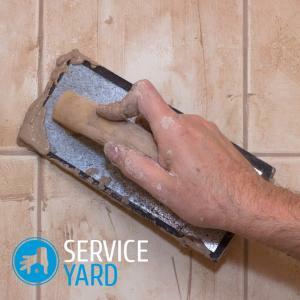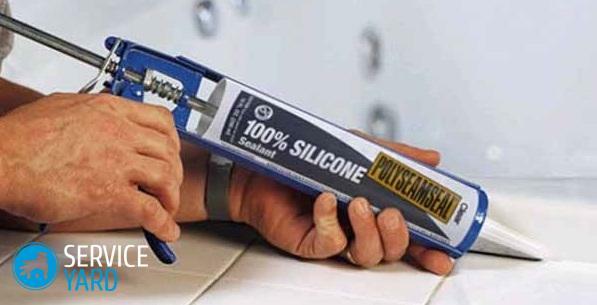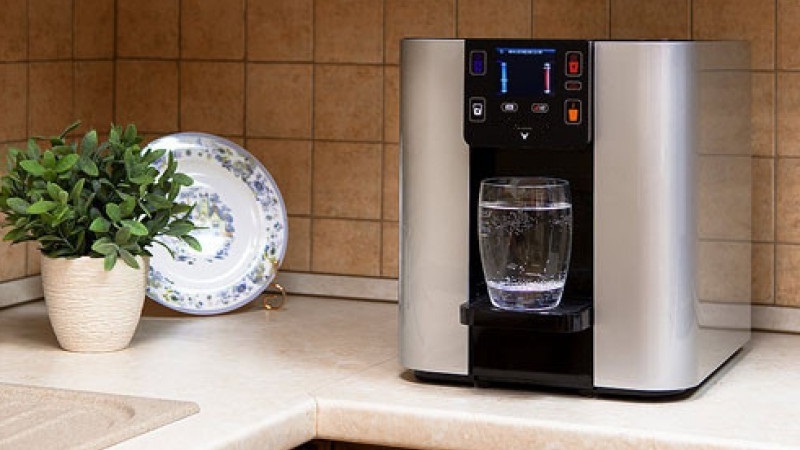
- Which seams require additional processing?
- Suitable building mixtures
- How to seal seams between tiles?
- Useful advices for
Even the simplest tiled flooring from an inexpensive monochrome collection can be transformed if you choose the right grout. And all the more it is necessary to approach the decision of the problem responsibly, than to cover the seams between the tiles in the bathroom, if you made the installation of a luxurious tile. Otherwise, all the labor and money will go to nothing, and within a month or two the walls will be covered with a layer of fungus, mold and dirt. How to cover the seams between the tiles and which solution is better suited for this purpose, you will learn from this article.
to the contents ↑Which seams require additional processing?
Tiles are usually laid in the bathroom on the walls and floors, sometimes - it also decorate the ceilings. But in addition to the decor of these surfaces, this room is equipped with various plumbing fixtures, furniture, additional decor. To ensure that this does not come very quickly to failure, and excessive moisture does not spread to other rooms, it is necessary to seal the seams:
- between the tiles and skirting boards or decorative baguettes;
- between tile and bathroom, sink;
- between the elements of the tiled floor.
For each of these purposes it is possible to take one type of solution or different, more suitable in this or that situation. Than just to cover the seams between the tiles in the bathroom - we understand further.
to content ↑Suitable building mixtures
The modern construction mix industry offers home builders and professional builders such a range of mortar for grouting joints:
- cement;
- epoxy;
- silicone.
Each of these options has its pros and cons. It is with them that you must first get acquainted, in order to more clearly understand for yourself, than to cover the seams between the tiles in the bathroom.

Cement
Cement mixtures have long been used to improve the strength characteristics and appearance of the tiled coating. In combination with such material, tile acquires a higher threshold of resistance to mechanical failure, the finished coating becomes more durable and practical. How beneficial to cover the seams between the tiles in the bathroom with a cement mortar, you can understand if you know about the merits of such a mixture.
Important! The composition of cement grout includes directly cement, sand, as well as additional components - colored pigments, plasticizers to improve certain properties.
Pros:
- Affordable price. Cement grouts are the cheapest of this group of building mixtures. They will be the best choice if you need to cover the seams between the tiles in the bathroom, and the budget is very limited and you can not hire a team of workers.
- Easy to use. Stacking cement mortar does not require special preparatory work and does not cause difficulties even for those who previously had no experience of doing such work.
- Versatility - with the help of such a solution you can seal any seams. And for wide and narrow seams there are on sale special solutions, which include substances of different degrees of fractionality.
- High mechanical strength. Seams with such a grout perfectly withstand direct physical effects, even in conditions of stably high humidity.
Cons
As a disadvantage, it is necessary to note the following features:
- not any kind of household chemicals is suitable for regular cleaning of tiles and sanitary ware;
- fouling gets stuck to the surface faster than using any other material;
- humidity makes itself felt much faster than with the use of other grouts, because in fact, cement is a water-soluble material.
Important! Cement mixtures are commercially available as a dry powder and a ready-made solution. The second type of grouting will cost a little more, but you do not have to waste your time and look for special tools for mixing - you will only need to open the container and use the solution as directed.
Epoxy Solution
Epoxy grout is universal in terms of the possibility of its use not only in the bathroom, but also in other rooms, and even on the facade of the building.
Advantages:
- Absolute resistance to any chemistry, so the choice of cleaning products remains at your discretion. No damage to the tile coating, none of the modern industrial means will not cause.
- High strength. Epoxy solutions after final setting acquire the highest possible strength for today. Therefore, even with direct mechanical action, the seams remain indestructible. On average, the life of this grouting is about 40-50 years.
- Absolute moisture resistance. Even with a very high humidity level or under conditions of constantly changing moisture index, epoxy grout not only does not collapse, but does not change its original properties.
- Fungus and mold do not appear on this type of surface, which is a significant plus in favor of choosing this particular material.

Disadvantages of
Despite the excellent technical characteristics, there are several nuances in the application of such a solution, which can become an adequate reason for preferring another building mix. In particular, the following are disadvantages:
- The component composition imposes certain limitations on the technical side when performing work. The solution requires independent mixing of the ingredients, resulting in a mass with a sufficiently high viscosity. Therefore, without the skills of working with such building material, one can not independently cover the seams between the tiles in the bathroom qualitatively.
- The cost of solutions with such a composition is an order of magnitude higher than for cement or silicone mixtures. And since for many people it is the price that determines the factor, epoxy blends do not take first place in the popularity rating of the grouts.
- Special health conditions for health. In liquid form, the solution is toxic - not only for the skin, but also for the mucous internal organs. Therefore, work is mandatory only with the use of personal protective equipment, outsiders should not be present at the same time. Start the operation of the bathroom only after the final hardening of the solution. That is, for the period of construction work and after their completion, for some time all the tenants of the house should be in another place.
Important! The palette of shades of grouts with such a foundation is one of the richest. Including, you can choose a solution with sparkles, mother of pearl, metallized, in shades of gold or silver.
Silicone sealant
Silicone mixes have recently appeared on the market and immediately began to be in high demand for various repair tasks, including they are suitable for covering seams between tiles in the bathroom. The reasons for this are quite understandable.
Advantages:
- Affordable price.
- The widest color palette.
- High elasticity.
- Absolute resistance to moisture.
- Fungi and mold do not appear.
- Surface is less soiled.

Cons:
- Suitable as a sealant only for sealing seams between tiles and plumbing, for hardening joints and corners. As a full grouting joints between the tiles, such material is not used.
- It is not allowed to use in places where there is a point of drinking water intake.
- Low mechanical strength.
- The yellowing of the surface may occur after a certain period of time.
- High consumption of the mixture.
Conclusion - what grout for seams is better?
Based on the above properties and features of each of the possible options to cover the seams between the tiles in the bathroom, you can draw such conclusions:
- Cement mixes remain in the first place in popularity. They are suitable for sealing any joints, inexpensive, relatively strong and safe.
- Epoxy - good from a technical and aesthetic point of view, but require more financial investment. Plus, their use is associated with a serious risk to health, if there is no relevant experience.
- Silicone - is suitable as an auxiliary component to improve the properties of cement composition and increase its protective, strength characteristics.
On how to properly cover the seams between the tiles in the bathroom with a cement mixture and silicone, we'll explain below.
Important! Pay attention when choosing a grout for the manufacturer. Reliability and reputation of a particular brand are sometimes decisive factors for obtaining a truly high-quality tile coating. The most popular products for today are the goods from such companies:
- Ceresit( Henkel, Germany).
- Litokol( Italy).
- Knauf( Germany-Russia).
- Kiilto( Finland).
- Mapei( Italy).
- Unis( Russia).
- Atlas( Poland).
How to seal seams between tiles?
There are several techniques for covering seams between tiles in the bathroom, so you can easily choose the one that will be more convenient and affordable for you. But before you cover the seams between the tiles in the bathroom, you need to perform a number of activities. Their quality will depend on the final result.
Preparatory stage
To properly prepare the surface for sealing joints between tiles, proceed as follows:
- Wait until the tile adhesive solidifies completely.
- Clean the tile from drops of adhesive, using suitable washings for this.
- Remove all the crosses used to maintain the clearness of the seam dimension.
- Rinse the tile well.
- Cover with a paint tape to make it easier to observe the thickness of the grout grout and the cleanliness of the finished tiles on the entire surface.
Important! If you choose unglazed tiles, moisten the edges with water. Otherwise, it will absorb moisture from the trowel and, as a result, the seams will burst and crack.
Once you have completed all the preparatory work, it's time to start the process itself - to cover the seams between the tiles in the bathroom. You can do this in one of the following two ways.
Method 1:
- Open the container with the solution and mix thoroughly.
- If you purchased a dry mix, prepare according to the recipe indicated on the package. But do in the amount that you will have time to use before solidification, otherwise - you have to prepare a new grout. It can not be further diluted or used at the end of the working time of the solution.
- Take a rubbery narrow spatula.
- Collect a small amount of the mixture on the work surface.
- Apply to seams, slightly pressing the mixture into the gaps, holding the tool at an angle of 30 degrees.
- Process the whole surface of the plot in 1-2 m2 with vertical and horizontal seams.
- Then, begin grouting the next section.
- After 5-7 minutes after applying the grout, wipe the surface with a damp cloth.
Important! Take into account that if you decide to make all the vertical seams along the entire wall and then horizontal seams, the second one will have difficulty in smearing, since the previous cement slurry will already be frozen.
Method 2:
- Buy a special grouting bag.
- Before use, put a suitable tip on the tip.
- Type a mortar inside the bag.
- Slightly press down and at the same time seal the seams, starting from the top, strip all the way to the bottom.
- To improve the quality of the seam, it can also be carried out in the opposite direction.
- As soon as the solution dries - form the final seam size and remove the excess.
Useful advices
The seams between the tiles need to be sealed not only from a technical point of view. It is the grout that gives the finished look to the tiled surface, makes it more attractive and bright. Therefore, to select the color of the mix, take it very responsibly, taking into account such advice:
- If the tile is dark, for contrast, you can take a mortar to seal the seams by 1 tone darker.
- If the tile is light - on the contrary, 1 tone is lighter.
- For the decoration of a tile panel or mosaic, it is better to take a colorless solution.
- If you need to visually combine all elements of the tile with different tinting or pattern - take a light grout.
- If on the contrary, you want to make a bright contrast and visually separate each part from each other, apply a solution of one of the dark colors.
- White grout - universal, it comes to tile of any shade, with a pattern, without it.
- When choosing a multi-color tiled coating, when on the same surface elements of different bright tones are combined, it is better to grout the color that is most in the interior as a whole.
- For floor tiles, use darker shades to avoid having to often wash away the quickly soiled coating.
Now you know not only what to cover the seams between the tiles in the bathroom, but all the features of doing this work. We hope you did not have to spend extra money on the call of the repairman and you were able to finish the interior decoration of the bathroom with your own hands. So - now you will get a double pleasure: from pleasant water procedures and the realization that you get this comfort due to your skills, skills and dedication.


